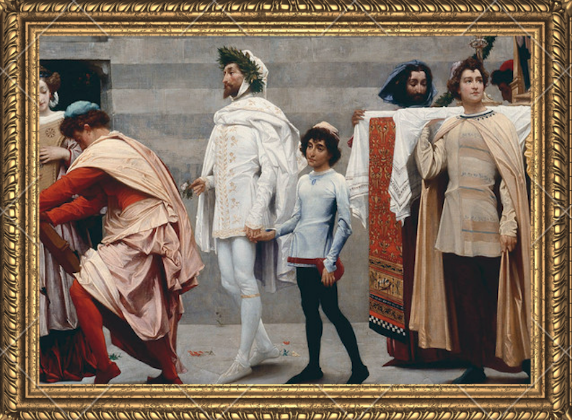Section 1:
Translating Vasari
“This work was an object of so much admiration to the people of that day that it was carried in solemn procession, with the sound of trumpets from his house to the church.”[18]
Vasari in Lives of the Artists
Though Cimabue’s Celebrated Madonna depicts an event from the 13th century, it was in its own way a very contemporary artwork. Leighton derived the subject from Vasari’s Lives, which had just appeared in English translation four years prior. This translation, and Leighton’s painting, both took part in a larger “rediscovery” of the Italian Renaissance in Victorian Britain. Like his contemporaries in the Pre-Raphaelite Brotherhood, Leighton sought to revive the principles and values of Medieval and Renaissance artists. However, his vision of that “Golden Age” differed from theirs; he identified more closely with his Italian predecessors, and recognized the Renaissance as one of artistic genius, which he had hoped to parallel through emulation. Cimabue’s Celebrated Madonna was only one of several paintings that Leighton completed in the 1850s on subjects drawn from Vasari’s text. In 1849, he produced Cimabue Finding Giotto in the Fields of Florence. In Vasari’s account of this narrative, he says:
“On the stones, the earth, or the sand, he drew pictures of things he saw or of his fancies. It chanced, one day, that Cimabue happened to see the boy drawing the picture of one of his sheep on a flat rock with a sharp piece of stone. Halting in astonishment, Cimabue asked Giotto if he would go with him to his house […] Under Cimabue’s guidance and aided by his natural abilities, Giotto learned to draw accurately from life and thus put an end to the rude Greek [Byzantine] manner.”[19]
Unfortunately, Leighton’s rendering of this subject is now lost, so we do not know how he interpreted this passage; however, his choice of this passage reveals his interest in the subject of artistic genius and its association with the flowering of the Renaissance. Three years later, in 1852, Leighton returned to this theme with The Death of Brunelleschi (Figure 3), which depicts the architect Filippo Brunelleschi at the moment of his death, seated and surrounded by mourners. In Vasari’s “Life of Brunelleschi,” he notes that the architect died at sixty-nine years of age, “after having labored much and having earned an honored name on earth and repose in Heaven.”[20] Here again, Leighton alluded to Vasarian narratives that celebrated the great achievements of the Renaissance era.
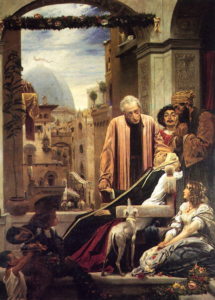
Figure 3. Frederic Leighton, The Death of Brunelleschi, 1852, oil on canvas, 113 x 89.4 in, Leighton House Museum.
With Cimabue’s Celebrated Madonna, Leighton attempted a more ambitious subject, combining two separate episodes from Vasari’s Lives. The first concerns the Rucellai Madonna‘s public reception and procession through the streets of Florence. As Vasari says in the text:
“This work was an object of so much admiration to the people that it was carried in solemn procession, with the sound of trumpets, from his house to the church.”[21]
The second anecdote involves King Charles of Anjou’s visit to see the work. This segment reads:
“There is a story, which may be read in certain records of old painters, that King Charles the elder of Anjou, brother of Saint Louis, as he passed through Florence, was shown the picture while Cimabue was painting it in a garden near the gate of San Pietro. It had not been seen by anyone. All the men and women of Florence crowded to see it with all possible demonstrations of delight.”[22]
In Leighton’s rendering of the combined frieze-like scene, we see Cimabue and Giotto in the center, surrounded on either side with a group of people who accompany the painting to the church of Santa Maria Novella. On the left, a crowd joins together in celebration; children sprinkle flowers on the ground, and a young boy carries a processional cross to the church. There are figures dancing and playing music, moving along with the crowd and expressing the gaiety of the procession. Several religious figures also walk amidst the group, and the gesture of the young child on the top left echoes the blessing of Christ, which mirrors Christ in the Rucellai Madonna. On the right, we see a grouping of figures who accompany the monumental painting; King Charles of Anjou can be seen on horseback entering the joyous scene. The stiff, stoic figures of Cimabue and Giotto contrast with the jubilant festivities that surround them, as they walk in front of the large, striped wall of Santa Maria Novella. In the background on a hilltop, we see the Florentine church San Miniato. In its gaiety and homage paid to the Rucellai Madonna, Leighton’s painting perfectly captures the Florentines’ quasi-religious devotion to art, and the Renaissance notion of artistic prestige.
Leighton’s work was one of sixteen works by various artists representing this particular anecdote from Vasari’s Lives. As the Whiteley Salon Index has recorded, between 1808 and 1866 there were sixteen works created based on the narrative, including Nicholas-Antoine Taunay’s Le Cimabué et Giotto (1808) and Förster’s Cimabue discovering the Young Giotto (1831-5).[23] However, Leighton did not strictly adhere to Vasari’s narrative; he altered some details to emphasize the theme of artistic genealogy, and pay tribute to the Italian masters. Leighton included Cimabue’s pupil and successor Giotto, whose presence at the event was not mentioned in Vasari’s Lives. Giotto’s placement beside Cimabue emphasizes the Vasarian idea of the Renaissance as a period when artists passed technical skills to their successors—a theme that resonated with his earlier portrayal of Cimabue.[24] To amplify this premise, Leighton included several other Renaissance artists in the scene: Arnolfo di Cambio, Andrea Tafi, Nicola Pisano, Buffalmacco, and Simone Memmi. Leighton in fact copied this part of the composition from Andrea di Bonaiuoto’s 1368 fresco Way of Salvation (Figure 4) from the church of Santa Maria Novella.[25]
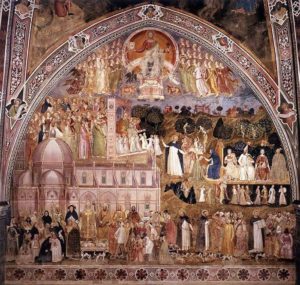
Figure 4. Andrea di bonaiuto, Way of Salvation, 1365, fresco, Cappellon degli Spagnoli.
This group stands directly behind the Rucellai Madonna. They can be identified from left to right as: a man wearing a tan head covering and green shirt, a dark-haired bushy-bearded man wearing a red cap, a man in a meditative state wearing a red coat with hands behind his coattail, and two figures wearing red behind them. The way Leighton represents these artists is significant: they all appear as pensive, intellectual figures in conversation who follow behind the esteemed artist and his painting.
In another important departure from Vasari’s text, Leighton included the Italian poet Dante, who can be seen leaning on the wall in the foreground. Contemporary viewers noted this figure’s prominent presence: as the Athenæum noted, “Leaning against a wall stands Dante, cold and soured, dreaming of Hell, and fancying he sees a procession in an avenue of Purgatory[…]”[26] The addition of Dante to this scene seems intended to call to mind a passage in the poet’s Purgatorio, which was translated into English in 1802:
“O vanity of human powers/how briefly lasts the crowning green of glory,/unless an age of darkness follows!/In painting Cimabue thought he held the field/but now it’s Giotto has the cry,/so that the other’s fame is dimmed.”[27]
In this passage, Dante uses the relationship between the master Cimabue and his student prodigy Giotto as a symbol of the fleeting nature of artistic success. Dante’s placement in Leighton’s painting, standing in front of the scene watching the procession, emphasizes and perhaps foreshadows Giotto’s succession of Cimabue. The reference to Dante not only demonstrated Leighton’s knowledge of the Dantean text, but was also surely calculated to underscore the theme of artistic achievement and its reception both at the time and afterward.
A final invented element in the scene is King Charles’s presence, who is riding on horseback near the rear of the procession. While King Charles’s passage through the streets of Florence and visitation to see the Rucellai Madonna was indeed included in Lives, Vasari does not mention his attendance at the procession itself. Perhaps his inclusion of the King within the scene was intended to highlight the significance of Cimabue and his acclaimed painting. The esteemed nature of the Rucellai Madonna in the painting highlights the significance of artistic production during the Renaissance. Patrons allowed for the vibrancy of Renaissance art, and were absolutely vital to the production of art during this time. This was a deliberate and effective pursuit for wealthy and powerful members of society to flaunt their splendor and prestige through displaying their wealth in such a manner. Evidence of patron-artist relations are often documented in contracts, in which the patron usually decided upon logistics such as cost of the work. Patrons often asserted their dominance and role in the process by suggesting specific themes or values in works that enhanced their status and power, such as inscriptions, coats of arms, or portraits. Since patrons were active in both religious as well as secular artistic production, they were an integral part of the formation of the Renaissance. Therefore, Victoria’s purchase signified a deliberate stride to embody the intellect and status of a Renaissance patron.
Stylistically, Cimabue’s Celebrated Madonna synthesized two different strains within Italian Renaissance painting, combining the Venetian emphasis on color and surface with the Florentine approach to line and drawing. While in Rome in 1853, presumably at work on the painting, Leighton wrote in a letter to his father:
“I was deeply impressed with the glorious works of art I saw in Venice and Florence and was particularly struck with the exquisitely elaborate finish of most of the leading works by whatsoever master; the highest possible finish combined with the greatest possible breadth and grandeur of disposition in the principal masses.”[28]
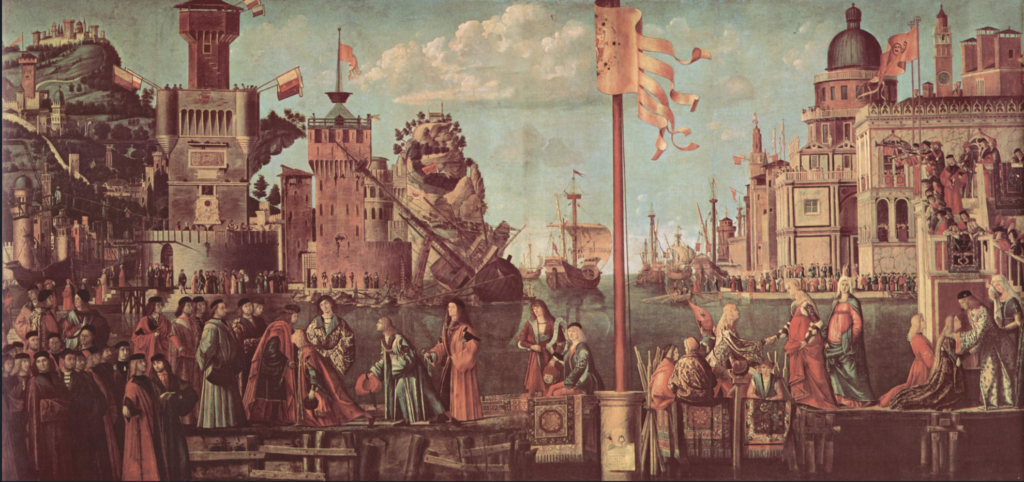
Figure 5. Vittore Carpaccio, Legend of St. Ursula, 1498, tempera on canvas, 149 x 232 in, Gallerie dell’Accademia, Venice.
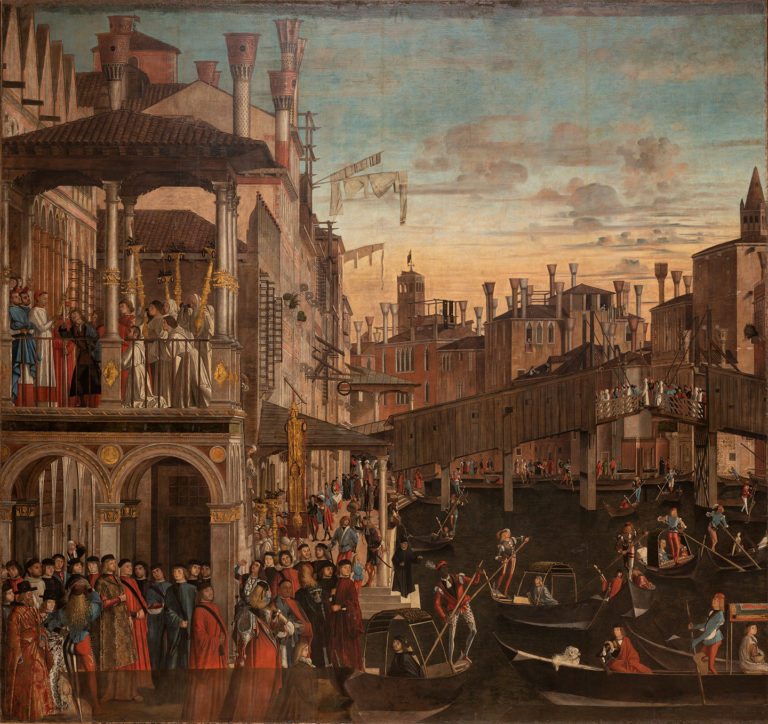
Figure 6. Vittore Carpaccio, Miracle of the Cross at the Ponte di Rialto, 1496, tempera on canvas, 146 x 154 in, Gallerie dell’Academia, Venice.
The composition of Cimabue’s Celebrated Madonna also alluded to works that visualized the pageantry of Venetian culture, such as Carpaccio’s The Legend of St. Ursula (1495; Figure 5) and The Miracle of the True Cross (1496; Figure 6), both of which Leighton would have seen while working in Venice.[30] What made Carpaccio’s works so celebrated were their seemingly factual replication of civic festivities. As Leighton made clear in the letter to his father, he took note of the “disposition in the principal masses” evident in Venetian narrative painting. This trait is arguably the most evidently Venetian aspect of Cimabue’s Celebrated Madonna: the work exemplifies what Patricia Fortini Brown calls the “eyewitness style,” in which the artist conveys Venice’s daily civic and religious culture within a compressed narrative scene. ‘Istorias,’ or accurate narrative paintings, were accorded documentary status and, Brown argues, were regarded as a record of events, rather than an artistic invention.[31] Bellini’s 1496 painting Procession in the Piazza San Marco (Figure 7), for example, depicts members of a confraternity in procession. In the center of the composition, we see the relic of the True Cross, said to have miraculous powers, being carried on a platform under a canopy, against the backdrop of bustling civic activities taking place in the square beyond.[32] Leighton’s composition is strikingly similar: he, too, portrays a procession in the foreground; a relic or important object in the center raised above; an everyday scene and a monumental architectural setting in the background.
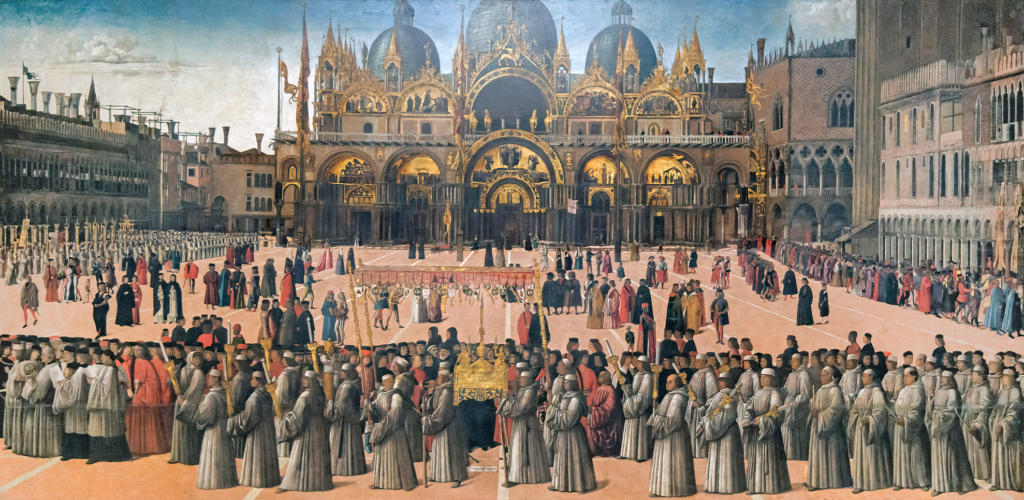
Figure 7. Gentile Bellini, Procession in the Piazza San Marco, 1496, tempera on canvas, 137 x 300 in, Gallerie dell’Academia, Venice.
Importantly, Leighton’s composition also echoed panoramic paintings of modern subjects then popular with the British viewing public. William Powell Frith specialized in his genre; his 1854 work Ramsgate Sands (Figure 8), which, like Leighton’s, was purchased by Queen Victoria, depicts a seaside resort on the Kentish coast in England. The painting symbolized the modernity and leisure that were embraced during the Victorian era. In the work, some figures look out to the sea, a group of children play in the background, a man in the center reads a newspaper, a trio of girls in the foreground play in the sand, some wade in the tide, and some simply relax on the shore. Not only does the work convey a popular retreat made by the Victorian working class, but it also represents the advancements of the Victorian age: Ramsgate was newly accessible to travelers due to the developments of the British Railway system.[33] The painting was a huge public success, and in 1854, the Art Journal predicted that Ramsgate Sands would become valuable “as a memento of the habits and manners of the English ‘at the seaside’ in the middle of the nineteenth century.”[34] Although greatly different in content, many compositional and stylistic elements of Ramsgate Sands are quite similar to Cimabue’s Celebrated Madonna, including the architectural backdrop, the crowding of figures in the foreground, the representation of mass joyous disposition, and the liveliness of the scene.
Leighton thus synthesized the traits of such popular modern panoramas with the characteristics of the Venetian “eyewitness style” to create a painting that was designed to appeal to the Victorian viewing public. Although the subject matter of Cimabue’s Celebrated Madonna was drawn from the past, the work was topical in its references to Vasari and the rise of interest in Venetian painting. By demonstrating his skill in emulating the great artists of the Venetian past, as well as his deep knowledge of Renaissance texts, Leighton aimed to align himself with the great artists of the past, and thereby to herald a rebirth of these values in modern Britain.
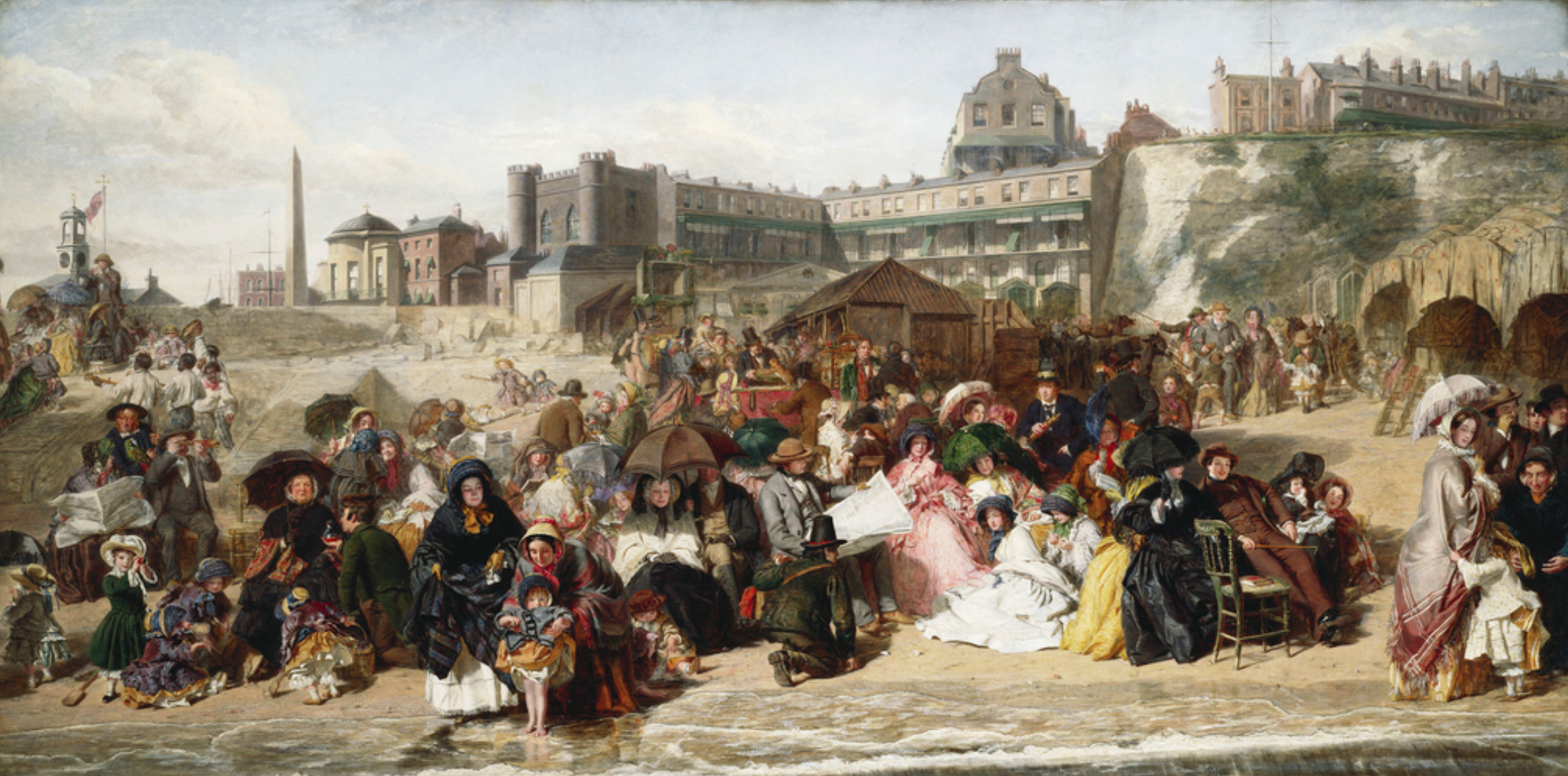
Figure 8. William Powell Frith, Ramsgate Sands, 1851-54, oil on canvas, 30.3 x 61 in, Royal Collection Trust.
Scroll over each of the circles to learn more about some of the many details in Cimabue’s Celebrated Madonna.
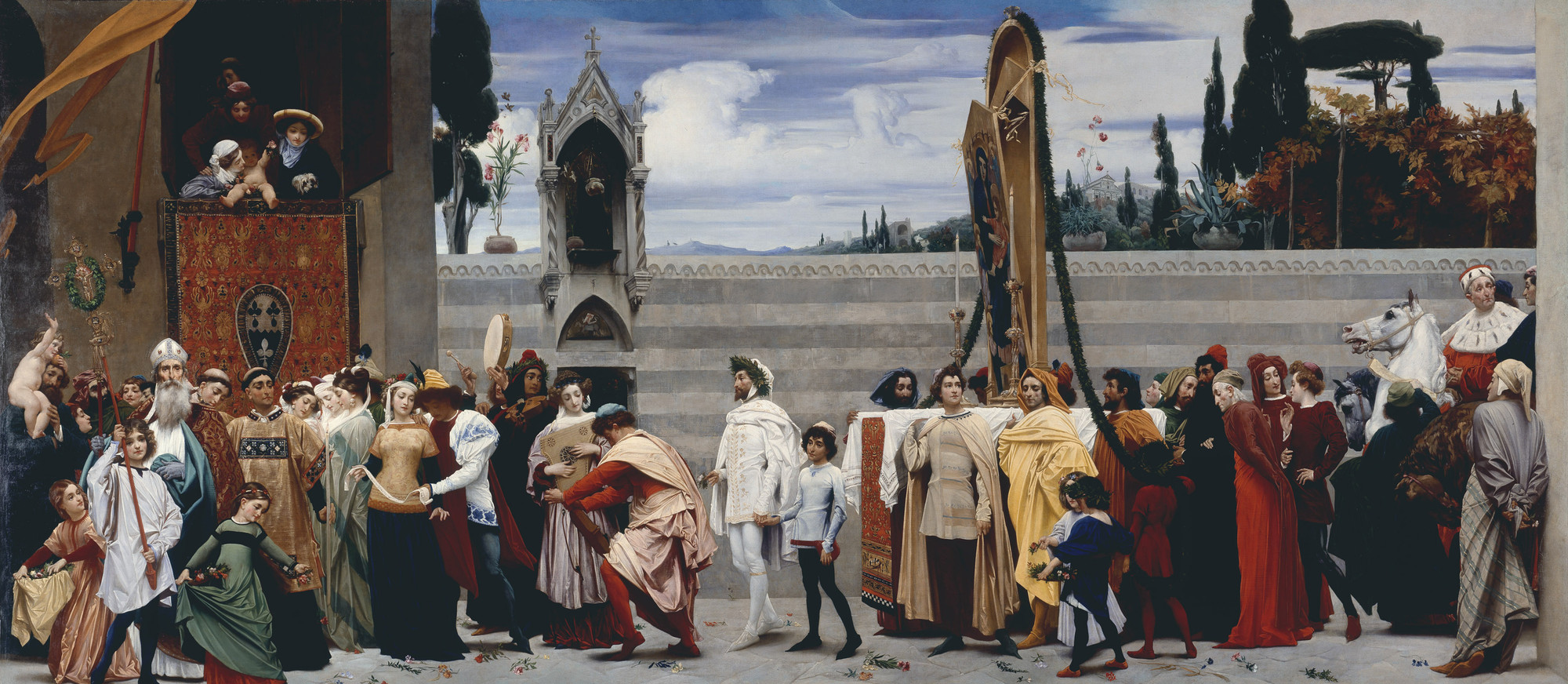
In the center of the composition walks Cimabue, holding the hand of a young Giotto as they walk before the Rucellai Madonna. He is crowned with a laurel wreath, and dressed in white, separating him from the rest of the celebratory composition.
Holding Cimabue’s hand is his successor, Giotto.
This is Cimabue’s painting the Rucellai Madonna, created in 1286. While unknown to Vasari at the time, the painting was actually later attributed to Duccio. Leighton’s choice of placing the painting at an angle so that it is not entirely visible is an interesting one. Rather, Leighton chose to focus his attention on the celebratory aspects of the painting’s journey to the Santa Maria Novella.
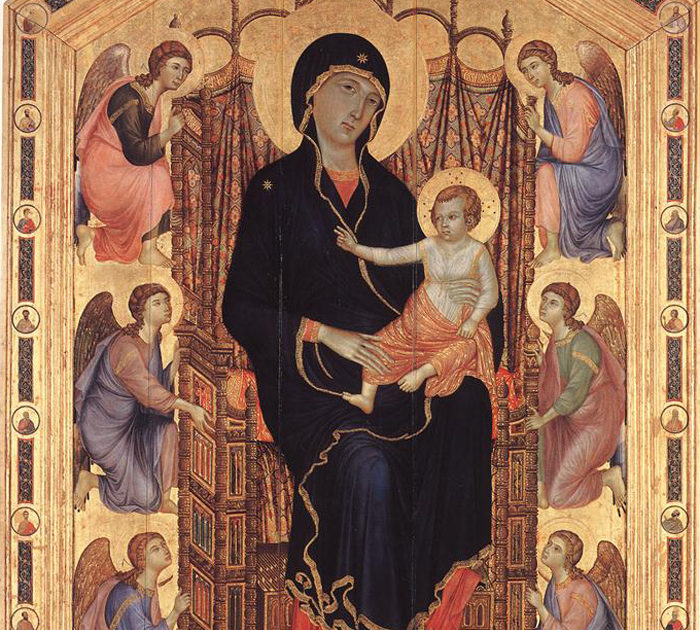
Rucellai Madonna
There are numerous religious figures in the painting, such as this one, who engages with the viewer and leads the procession to the church. From his appearance, we can gather that he is Priest or religious leader, and is embarking on the painting’s procession to the church of Santa Maria Novella, where it would be hung.
Another religious figure, this child engages with the viewer, and carries a processional cross.
This baby’s pose echoes the blessing pose of Christ, and appears to lead the procession to the Church of Santa Maria Novella.
Surrounding the Rucellai Madonna is a group of Florentine artists, believed by Leighton to be Andrea Tafi, Nicola Pisano, Buffalmacco, Simone Memmi, and Arnolfo de Lapo. While scholars have a difficult time pinpointing who is who in this image, we do know that Leighton had created preparatory drawings on these figures, based on the 1368 fresco Way of Salvation by Andrea di Bonaiuoto.
This is King Charles of Anjou, riding on horseback. His presence in this specific procession was not mentioned in Vasari’s Lives. However, it is known that the King visited the painting.
Dante Alighieri, in the Purgatorio, had depicted through the mouth of Oderisi, Cimabue and Giotto as the reformers of painting after the Dark Ages. He is leaning near the outskirts of the composition, who watches his own scene unfold. In the text, he says, “In painting Cimabue thought to hold the field and now Giotto has the cry, so that the other’s fame is dim.” The work was contemporaneously relevant, and many viewers would have been familiar with Purgatoria.
The striped wall behind the figures is a depiction of the architecture of Santa Maria Novella, which would be the final destination for this procession. Leighton’s attention to architectural detail was admired by critics such as John Ruskin.
We can gather the festive nature of the procession through elements such as these figures playing musical instruments. John Ruskin commented on the laborious and accurate appearance of the architecture in the work, such as this one.
This figure is thought of to be a caricatured portrait of Leighton, himself.
In the background, we see San Miniato surrounded by Cyprus trees.
